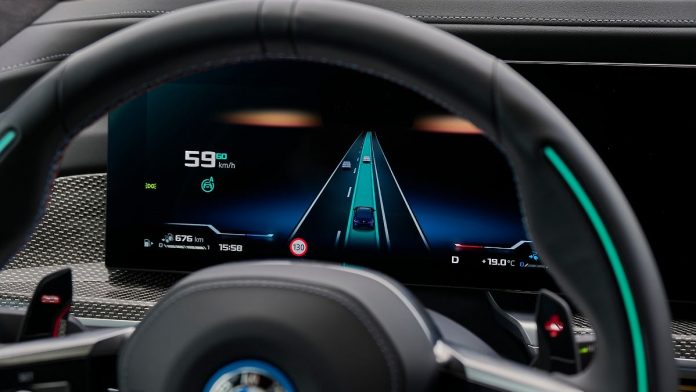There probably won't be any truly autonomous cars in Germany that quickly. Because what works brilliantly in theory fails miserably in reality. Ilja Radusch from the TU Berlin draws a sobering interim conclusion and says: “We underestimated the complexity.”
The law on autonomous driving came into force in July 2021. According to the Federal Ministry of Transport, the goal was to “bring vehicles with autonomous driving functions into regular operation” by 2022, which would make Germany “the first country in the world to bring vehicles without drivers from research into everyday life.” It is now 2024 and fully automated cars are still not part of everyday German roads.
The ADAC quotes from a Prognos study, according to which the technology will only become established from 2040. The transition phase will be characterized by highly automated driving situations: when parking cars in parking garages, in traffic jams and driving in convoys on the highway, writes the automobile club.
This is the third stage in a five-stage plan for autonomous driving. The current level 4 is fully automated driving, in which the system takes over complete vehicle control, but in an emergency a human or external technical supervision can take over.
Ironically, accidents that have recently occurred with autonomous vehicles are one reason why level 4 will probably not be reached for several years. To this day, a McKinsey study from 2015 is still regularly used in the argument for autonomous driving, according to which the technology could prevent up to 90 percent of all accidents.
90 percent fewer accidents possible
The logic is clear, because as the Ministry of Transport states in Take Off the Gas, 91 percent of all accidents are due to human error. These include excessive speed, too little distance, disregarding the right of way or other driving errors such as making the wrong turn. So you can say that the lower the human factor, the greater the security.
However, the calculation only works if artificial intelligence (AI) works correctly in collaboration with sensors and other technology. Because even if it could prevent perhaps 85 percent of accidents, it would not receive approval. To do this you would have to be able to trust her practically 100 percent. As some events in recent months have shown, this is clearly not the case so far. Among other things, the robotaxi company Cruise had to stop operating in San Francisco last November after several incidents.
In August 2023, the company's self-driving cars blocked a road after the cell phone network was believed to be overloaded. One car got stuck in fresh concrete at a construction site, another had an accident with a fire truck. Things got even worse in October, when a cruise car dragged a pedestrian several meters after she was hit by another car and thrown in front of the autonomous vehicle. As it had “learned”, it moved to the side to stay out of the way instead of stopping immediately.
“We have to consider the remote and hardly possible”
“From the point of view of us researchers, this accident is sobering because we would never have thought of programming such a situation before,” says Ilja Radusch, head of the Daimler Center for Automotive IT Innovations (DCAITI) at the TU Berlin. It turns out that “we have to take into account what is supposedly out of place or hardly possible.”
The scientist says that the complexity of urban road traffic in particular has been underestimated. It reminds us of 2013, when an autonomous vehicle retraced the route “fairly problem-free” that Bertha Benz had covered in 1888 with the automobile developed by her husband.


Ilja Radusch, head of the Daimler Center for Automotive IT Innovations (DCAITI) at the TU Berlin
(Photo: Philipp Plum, Fraunhofer FOKUS)
“Challenges of whether a computer manages to control the steering wheel finely enough or to 'see' far enough, even in rain and snow, were well overcome. Likewise, operating the accelerator and brake pedals in accordance with the requirements,” says Radusch. “And because everything worked so well back then, we thought that in five years no one would have to learn to drive anymore. But ten years later we are constantly faced with new detailed problems and the 'famous' 'unknown unknowns', i.e. the unknown unknowns – see accident.”
Computers must learn to act intuitively
He explains that people didn't take into account that driving is also accompanied by thousands of intuitive actions. The question is how to enable the computer to act intuitively. As an example, he cites spontaneous honking when someone turns without signaling. “Or, as the accident described shows, to stop immediately and not first pull over to the side and then stop.”
In a city where only autonomous vehicles are on the road, it would be easier because there would be less to expect that would be difficult to predict, says Radusch. “In addition, you could be traveling at a manageable 20 to 30 kilometers per hour. This increases safety, because at this speed emergency braking is possible without any problems. Serious and fatal accidents could be avoided.”
The question remains open as to whether transport capacities are sufficient at such speeds, the expert points out. “A maximum of 20 to 30 kilometers per hour means, for example, fewer customers per hour for a taxi company. Tram or subway may be more economical in such a scenario.”
There is no future without profitability
At the moment, autonomous driving is anything but economical. When analyzing the cruise accident, it emerged that 1.5 full-time employees were necessary to operate a driverless taxi. “But since we – especially in Germany – were hoping to use autonomous driving to counteract the labor shortage, for example among bus drivers, this number from Cruise was a brutal intrusion of reality into our research world,” explains Radusch.
“We researchers assumed that there would be one person in technical supervision who would monitor ten vehicles.” Without cost-effectiveness, autonomous driving would not be the first research idea that fails to gain acceptance in the real world.
From the sobering facts and findings, the scientist concludes that “it is obviously not possible to pull off a big one” and that a bridging technology such as teleoperated driving is needed. The person is not sitting in the car, but in a control center to which sensors transmit data from the vehicle's surroundings via the mobile phone network.
Teleoperated driving as a bridging technology
“In a situation, for example, in which the automated car is overwhelmed, the operator in the control center works out a solution based on the transmitted data so that the automated vehicle can continue driving,” explains Radusch. “This could also be an alternative for truck drivers to control the trucks across Europe using teleoperation. The truck driver could then always be with his family and friends in the evenings. And we need to put the question of the economic viability of this new technology much more into focus Take your sights.”
The expert also reminds us that autonomous driving with cars is not the only thing being researched. He currently sees the greatest potential in regional transport on the subway and S-Bahn. The fastest progress is possible there because it is not as complex as urban road traffic.


